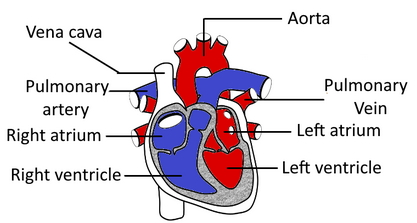
Ventricles have thicker walls than auricles. Why?
Answer
509.1k+ views
Hint: The heart has four chambers: two auricles and two ventricles. The right ventricle supplies deoxygenated blood to the lungs and the left ventricle supplies oxygenated blood to the body parts.
Complete answer:
The ventricles of the heart have thicker muscular walls than the auricles. This happens because the blood from the ventricles of the heart is pumped out of the heart at greater pressure compared to the auricles. The ventricles are responsible for pumping blood to various parts of our body.
Additional Information: -The heart is a muscular organ in most of the animals, which pumps blood through the blood vessels of the circulatory system of various parts of the body.
-The blood which is pumped carries oxygen and nutrients to the body and carries metabolic waste like carbon dioxide to the lungs.
-The size of the heart in humans is approximate to that of the closed fist and is located in the middle compartment of the chest, between the lungs.
-Our heart has four chambers, two small upper chambers called atria and two larger lower chambers called ventricles.
-The walls of the heart are made up of three layers: endocardium (inner layer), myocardium (middle layer), and epicardium (outer layer). The heart is surrounded by a double-membraned protective layer called the pericardium.
-The pacemaker cells present in the sinoatrial node (SA node) of the heart pump the blood with a rhythm.
-The right atrium continuously receives blood from the two major veins of the body, They are, the superior and the inferior venae cavae.
-The oxygenated blood is received by the left atrium back from the lungs through one of the four pulmonary veins.

Note: The key organ for blood circulation and the double circulation is heart is. It is an efficient way of circulation which is found in higher organisms. The double circulation includes two processes, they are systemic circulation - which carries oxygenated blood and the blood circulation starts from the left ventricles to the tissue capillaries and pulmonary circulation - which carries deoxygenated blood and blood circulation starts from the right atrium to the left atrium.
Complete answer:
The ventricles of the heart have thicker muscular walls than the auricles. This happens because the blood from the ventricles of the heart is pumped out of the heart at greater pressure compared to the auricles. The ventricles are responsible for pumping blood to various parts of our body.
Additional Information: -The heart is a muscular organ in most of the animals, which pumps blood through the blood vessels of the circulatory system of various parts of the body.
-The blood which is pumped carries oxygen and nutrients to the body and carries metabolic waste like carbon dioxide to the lungs.
-The size of the heart in humans is approximate to that of the closed fist and is located in the middle compartment of the chest, between the lungs.
-Our heart has four chambers, two small upper chambers called atria and two larger lower chambers called ventricles.
-The walls of the heart are made up of three layers: endocardium (inner layer), myocardium (middle layer), and epicardium (outer layer). The heart is surrounded by a double-membraned protective layer called the pericardium.
-The pacemaker cells present in the sinoatrial node (SA node) of the heart pump the blood with a rhythm.
-The right atrium continuously receives blood from the two major veins of the body, They are, the superior and the inferior venae cavae.
-The oxygenated blood is received by the left atrium back from the lungs through one of the four pulmonary veins.

Note: The key organ for blood circulation and the double circulation is heart is. It is an efficient way of circulation which is found in higher organisms. The double circulation includes two processes, they are systemic circulation - which carries oxygenated blood and the blood circulation starts from the left ventricles to the tissue capillaries and pulmonary circulation - which carries deoxygenated blood and blood circulation starts from the right atrium to the left atrium.
Recently Updated Pages
Master Class 12 Business Studies: Engaging Questions & Answers for Success

Master Class 12 Economics: Engaging Questions & Answers for Success

Master Class 12 English: Engaging Questions & Answers for Success

Master Class 12 Maths: Engaging Questions & Answers for Success

Master Class 12 Social Science: Engaging Questions & Answers for Success

Master Class 12 Chemistry: Engaging Questions & Answers for Success

Trending doubts
What is meant by exothermic and endothermic reactions class 11 chemistry CBSE

Which animal has three hearts class 11 biology CBSE

10 examples of friction in our daily life

One Metric ton is equal to kg A 10000 B 1000 C 100 class 11 physics CBSE

1 Quintal is equal to a 110 kg b 10 kg c 100kg d 1000 class 11 physics CBSE

Difference Between Prokaryotic Cells and Eukaryotic Cells




